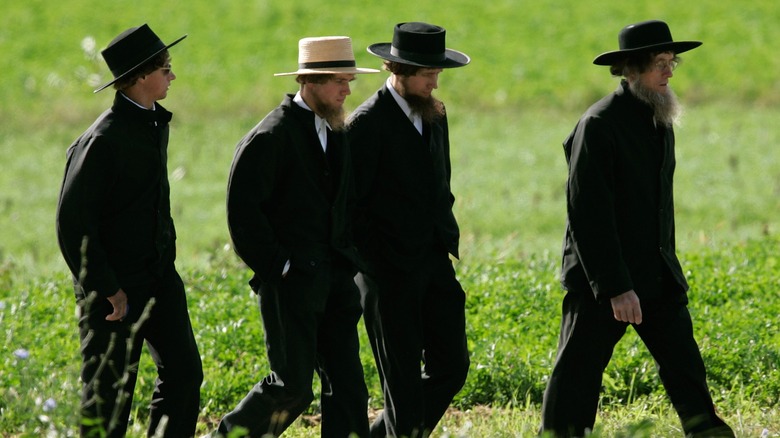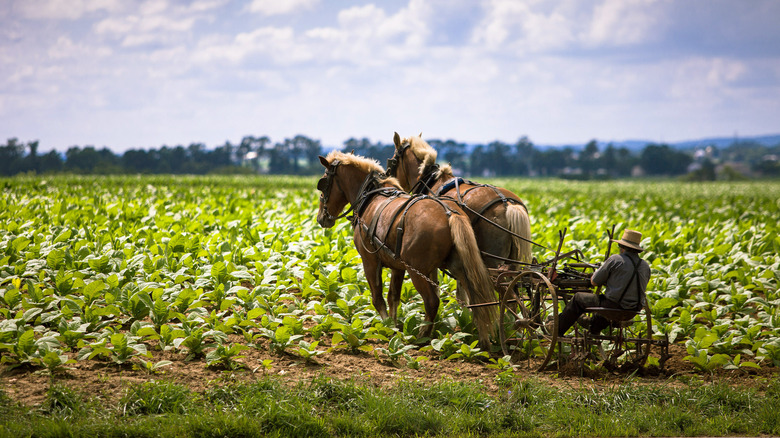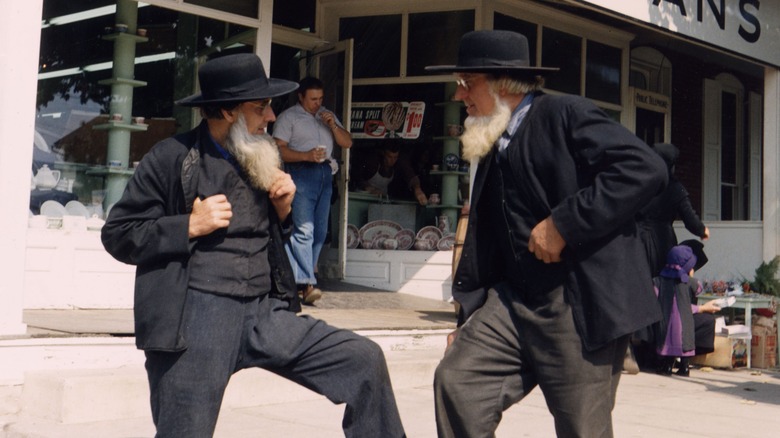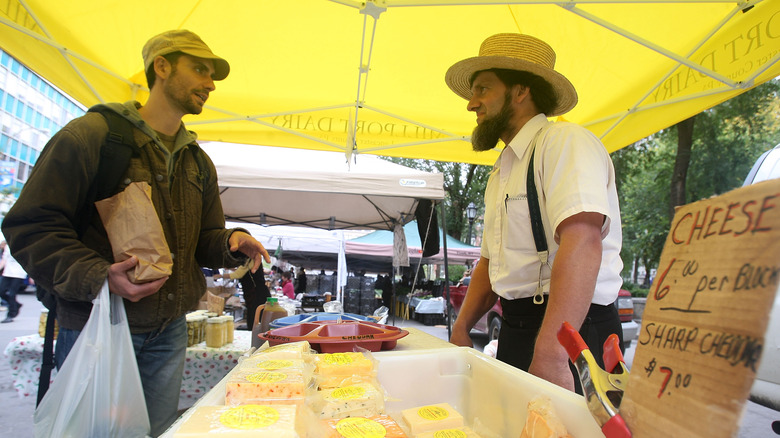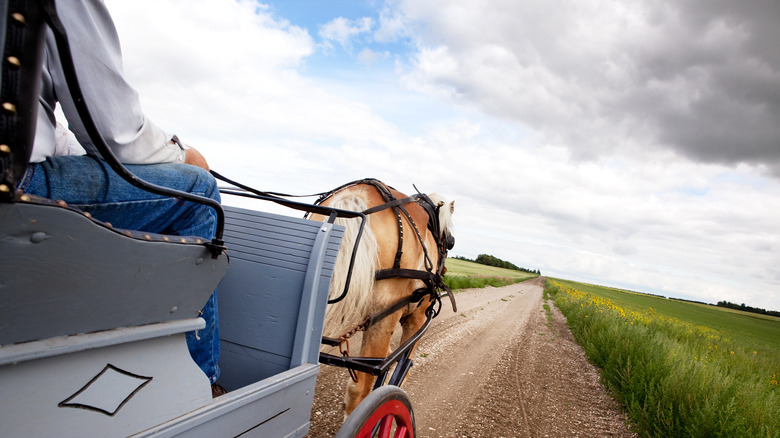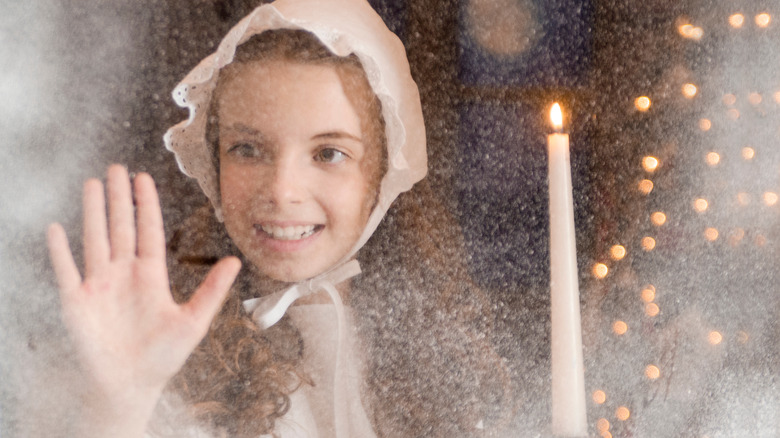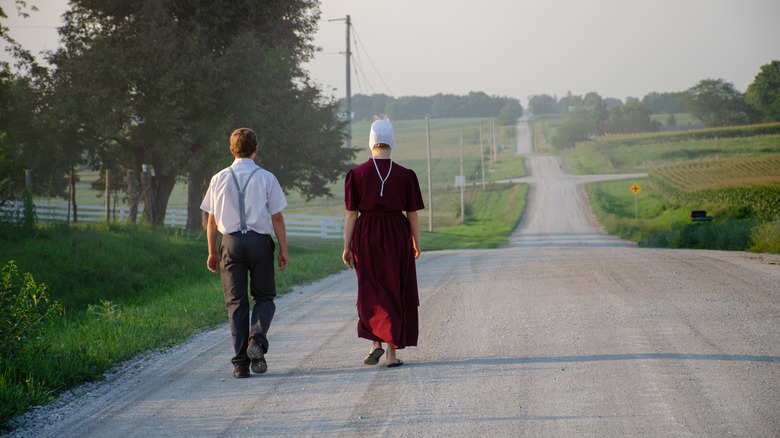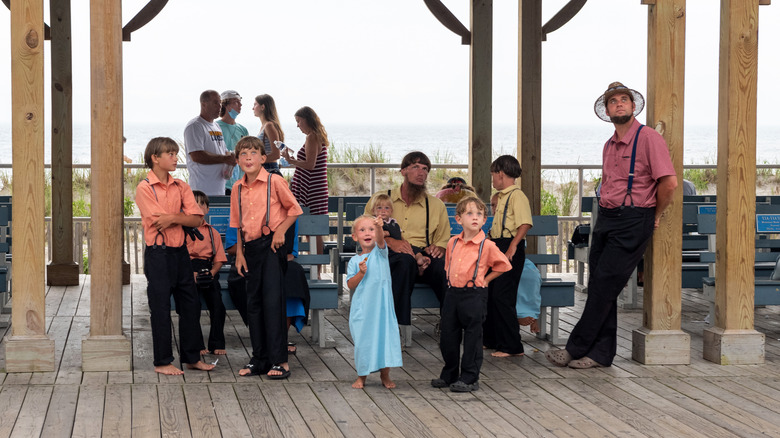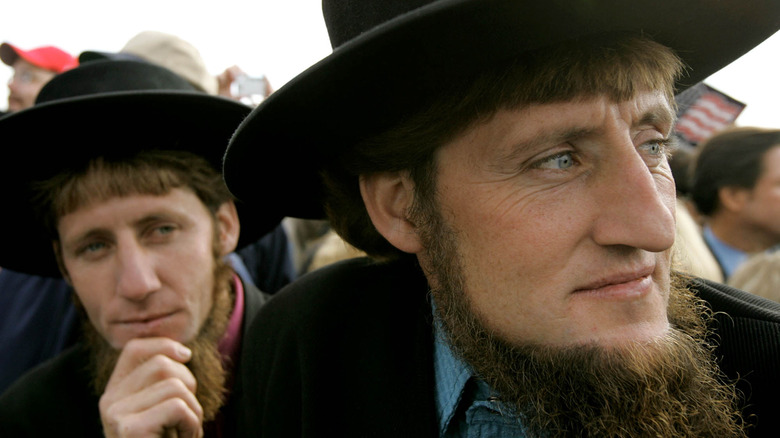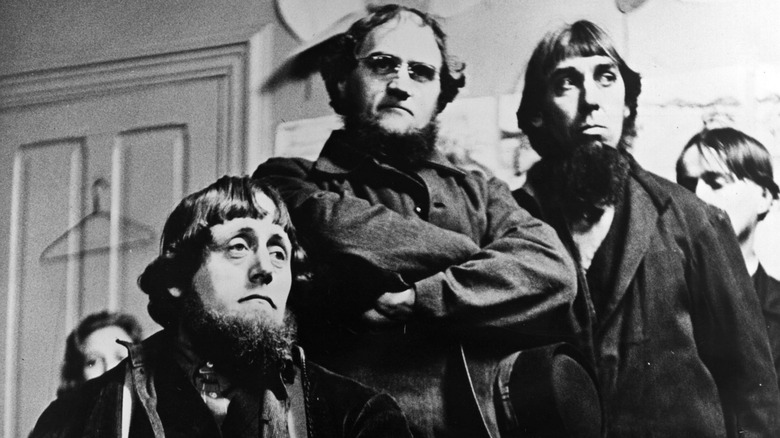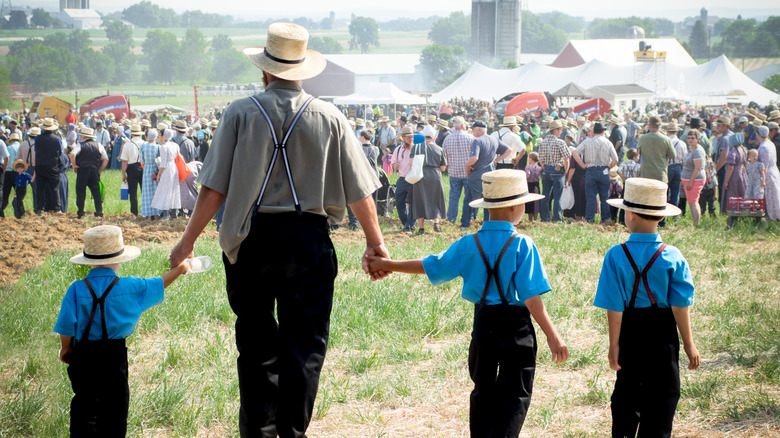Things You Get Wrong About The Amish
The Amish are a peculiar group in the U.S. Isolated and private, they don't usually dominate the imaginations of mainstream Americans. When they do show up in our pop culture, on television shows like "Banshee" or "Amish Mafia" or in films like "Witness," they're often viewed as curiosities, bizarre and fascinating.
That leads to a lot of misconceptions. If you're like most people, when you hear "Amish," you think of horses and buggies, men with long beards and wide-brimmed hats, women with head coverings and old-timey dresses. And you probably assume a lot of things about the Amish based solely on how they're portrayed in the media — or perhaps you've vaguely heard about rumspringa, the traditional period when teenagers leave the family home and venture into the wider world in order to better understand both their material and spiritual lives.
But whatever you think about the Amish, chances are good you're wrong. Whenever a group is reduced to a short list of easy clichés and visual signifiers, the truth gets lost in the noise. While the Amish communities in the United States are distinct cultures that reject much of what the rest of America takes for granted, there's a lot more to the "plain people" than just beards and buggies. Here are all the things you get wrong about the Amish.
They're not all farmers
When you think about the Amish — if you think about them at all — you think of hard-working men who farm their land and then haul their crops into town. And it's true that farming as a way of making a living is central to many Amish communities. The Amish believe strongly in maintaining the rural traditions of their forefathers, for one, and farming is seen as a way for fathers to stay home and close to their families instead of having to travel out to a job outside of their community.
But as NPR notes, a growing number of Amish are choosing not be farmers. In fact, in Lancaster County, Pennsylvania — home to one of the largest and fastest-growing Amish communities in the country — there has been a sharp increase in requests for permission to house horses on residential lots. This is because many young Amish are moving off the family farms to work at different occupations. Those occupations include carpentry, construction, or even owning small businesses and shops in town.
Another reason for the decline in Amish farming is the difficulty in subdividing farms to provide an inheritance for sons as well as the rising costs of land. While farming remains a core part of the Amish lifestyle, the Amish are increasingly economically diversified.
They use electricity and phones
If you know one thing about the Amish, you know they're not allowed to use modern technology. Except, of course, they are — and they do.
As explained by MUO, what most people misunderstand about the Amish is that they don't ban the use of electricity, or technology in general. Most of their restrictions (which vary from one community to another) are focused on the connection to the outside world (they refer to the rest of us as English, by the way). Connecting to an electrical grid would connect them to influences they'd rather avoid — not to mention make it very easy for those influences to come in via television, radio, and the Internet.
As reported by Lancaster Online, the Amish do, in fact, use a lot of technology, including cell phones, computers, and gas generators. As long as these technologies are generally kept outside of the home, they're perfectly okay. Wired notes that Amish communities have extremely elaborate systems for determining whether a technology is acceptable and how it can be used.
There isn't always agreement. Back in the 1920s, a serious schism occurred within the Amish world over the telephone, and in the modern day, the use of cell phones is a controversial gray area. The Amish resist having telephones in their house because of the interruption it would represent. But they don't reject technology out of hand — they just think really long and hard before allowing it into their world.
They speak English — and more
To modern Americans, the Amish may look like a group of people from another country (or another world). But despite appearances, the Amish do, in fact, speak English. And unlike some other misconceptions, they don't speak in antiquated Old English — they speak more or less like everyone else.
In fact, according to Amish America, they speak several languages. The Amish will speak English when outsiders are present, out of courtesy. Among themselves, they'll speak a dialect of German called Pennsylvania Dutch (the "Dutch" part is a corruption of "Deutsch," the German word for its own language) or, in some areas like Indiana, a dialect of Swiss. Since Pennsylvania Dutch is not a written language, they generally use German or English when writing things down. And they use a dialect called High German in their church services and religious writings.
According to Babbel, about 400,000 people speak Pennsylvania Dutch in North America, and the number of people speaking the language is doubling every 20 years or so thanks to high birth rates among the Amish. And there are non-Amish who speak the language — the Amish call these people the "Fancy Dutch." It's a shrinking group, however, as many of the Fancy Dutch have started speaking English exclusively.
They pay most taxes
Since the Amish work hard at remaining separate from the larger modern world around them, it's easy to assume they have none of the connections — or obligations — that the rest of us deal with. It's a common rumor that the Amish don't pay any taxes, but this is not true.
What is true is that the Amish tax situation is complex. As explained by Scaringi Law, they don't pay Social Security or Medicare taxes, but they do pay income tax, sales tax, and property taxes just like everyone else. The Amish regard Social Security and other government programs as contrary to their beliefs and lifestyle, so they don't accept Social Security, unemployment, or other benefits that are funded by taxes. The Amish believe in self-sufficiency and the care for each other as a community, rejecting any reliance on the wider world that might bring in corrupting influences.
How Stuff Works explains that this took a long time to sort out — the Amish clashed with the government over these taxes for years. They finally received a religious exemption in 1965. They're actually not alone in this exemption, as railroad workers also don't have to pay Social Security taxes.
They can ride in cars
Because the popular image of the Amish includes those iconic horse-drawn buggies and intolerance of technology, many assume the Amish are forbidden to even ride in an automobile. This is absolutely untrue — in fact, the Amish use cars a lot. They just don't own or drive them.
The Philadelphia Inquirer reports that there's actually a thriving business driving the Amish around, referred to as "haulin' Amish." It's sort of like a low-tech Uber, where Amish folks call to make appointments ahead of time. They use car services to get to places where horses can't easily go, to haul groceries or other loads, and to get to their jobs outside their community.
According to Business Insider, you can make decent money haulin' Amish. They pay by the mile (one driver got 60 cents per mile) and then pay $10 an hour if you have to wait while they shop or conduct their business. Flat-rate jobs also come along, like being paid $120 to pick up a family for a grocery run every Saturday.
And sometimes the Amish need those cars to get to charter buses so they can go on vacation. Yes, as noted by The New Yorker, the Amish go on vacation just like other families — primarily to Florida. While on vacation, the usual rules are somewhat relaxed, and the Amish can literally let their hair down.
They use modern medicine
Because the Amish religion and lifestyle emphasizes "plain living" that eschews most modern comforts and connections to the world around them, it's easy to assume they live a primitive life, including their medical care. The idea that the Amish rely on home remedies and old-timey medicine is completely wrong, though. As Ohio's Amish Country explains, there's actually nothing in the Amish religion that forbids the use of modern-day medicine. The Amish can and do go to regular doctors, specialists, and even hospitals.
What truly sets the Amish apart in terms of health care is insurance: They don't use it. Any kind of it. Instead, as NBC News notes, the Amish pay for their medical care in cash — often paid for by the entire community. It's actually a pretty complex system involving church funds and benefit sales. But although the Amish reject insurance, they don't reject one of the main reason people like getting their health insurance through their jobs: collective bargaining. One of the key ways an Amish community manages their health care costs without insurance is by negotiating with local hospitals for the best prices.
However, the Milwaukee Journal Sentinel reports that some Amish do hesitate to go to doctors or hospitals because they fear they will be under the control of people who do not share their beliefs. As a result, they tend to rely more on local doctors in nearby communities, who they trust to respect their lifestyle.
They celebrate the same holidays we do
As explained by the Milwaukee Journal Sentinel, the Amish are a subset of Christianity known as "Plain People." They are deeply religious and keep themselves separate from the modern world, dressing and living as plainly as possible.
But that doesn't mean they don't celebrate life. According to Amish America, it's true they don't celebrate many secular holidays — although if they're employed and their job gives them the day off, they'll take it. But they celebrate Thanksgiving, Christmas, and New Year's, and they will attend Fourth of July celebrations. Unsurprisingly for a strict Christian community, they don't observe Halloween, but they do decorate with pumpkins and other gourds in the Autumn.
Christmas is just as big a deal for the Amish as for other Christians (and non-Christians), although they celebrate in a less flashy manner than us "English" (their word for non-Amish people). According to Discover Lancaster, Amish communities celebrate both Christmas and "Second Christmas" (December 26). In fact, lavish dinners and gatherings can continue well into February. They exchange small, homemade gifts between family members, bake cookies, and make candy. And they make their own Christmas cards, which they'll often send to their "English" friends. The children will often put on a Christmas pageant just like other families around the country.
They don't do arranged marriage
There's often an assumption that when a tight-knit religious community is isolated from the world, they must rely on arranged marriages to ensure no one wanders away. The truth is the Amish get married the old-fashioned way, but it's all perfectly voluntary.
As noted by How Stuff Works, Amish communities are extremely close. They spend most of their time together, and most members of a community know each other intimately from birth. That means that by the time they reach courting age, they've forged some very strong relationships with their neighbors. The courtship process is extremely charming and old-fashioned, beginning with a male suitor giving a woman rides to and from church or community gatherings known as "singings." After a while, the couple will be allowed some privacy. The woman, it should be stressed, is a full participant in choosing her husband.
One thing the Amish do not believe in? Divorce. According to Men's Divorce, the Amish Church does not have any provision for divorce. Getting a civil divorce would violate the oath an Amish person took at their baptism. (Unlike many other Christians, the Amish are not baptized until they are at least 18 years old.) Breaking the vow of marriage can lead to excommunication and what's known as "shunning," wherein the offender's neighbors and family refuse to communicate or interact with them until they correct their behavior.
The Amish are pretty diverse
We tend to use the phrase "the Amish" pretty loosely, as if everyone we see driving a horse and buggy were exactly the same. But there's a lot of diversity within that community.
First and foremost, as noted by the York Daily Record, the Amish are actually just one group within the larger category of "Plain People." This includes Old Order Mennonites and other, less well-known groups. These groups are linked by a simple lifestyle and a rejection of modernity, but they are often quite distinct in their specific beliefs and ways of life.
As Ohio's Amish Country explains, there are four major divisions within the larger Amish community: The Old Order, the New Order, the Beachy Amish, and the Swartzentruber Amish. The Old Order are the strict, old-school version (and the largest of the four groups). The New Order broke away from them and have slightly more relaxed rules. The Beachy Amish have incorporated aspects of evangelical religions into their services and also have slightly more relaxed rules about dress and technology — they allow people to drive cars, for example. The Swartzentruber Amish are hardcore: They're the strictest and consider themselves the true Amish.
They're not an ethnicity
One of the biggest mistakes people make when discussing the Amish is to assume that because they speak a different language among themselves, dress in a unique, culturally specific way, and hold themselves apart from modern society, they're an ethnic group of German or Swiss descent. But that's not technically true. As noted by Jeremiah Raber, while most Amish do descend from German and Swiss genetic lines, they use the term "Amish" to identify members of their community, in the same way they use the word "English" to describe anyone outside their community, regardless of race.
That means that anyone can become Amish. As noted by LancasterPA.com, the Amish allow outsiders to convert and join their church and community — although it isn't easy. You must embrace the lifestyle and live as a plain person, you'd better learn to speak Pennsylvania Dutch, and you'll have to convince them that you're serious. And as Amish America explains, the Amish are not evangelicals — they do not preach to people and attempt to recruit. So if someone wants to become a member of an Amish community, they will have to take the initiative.
This is also behind the purpose of the rumspringa, the period of exploration that teenage Amish experience. They must return to their community and choose to be baptized into the Amish faith after they have seen the alternatives.
They have a dark side
The Amish are known to be a pretty gentle — albeit strict — folk. Britannica notes that they are officially pacifists and refuse to serve in the military, but it goes deeper than that. Amish America explains that the Amish actually believe in a principle of "non-resistance" that applies to every aspect of their lives. That's why they won't sue in courts of law and why they don't deal with the local police. That gentle approach to life gives people the impression that the Amish are too pure for this world — but the fact is the Amish have their own dirty laundry just like everyone else.
According to Type Investigations, the isolation and secrecy of Amish communities can hide horrifying sexual assault and child abuse. When the victims have the courage to speak up, they are often pressured by the community not to involve the local authorities — and Amish communities often have agreements with local police to let them handle their own problems. They are sometimes threatened with excommunication and shunning if they don't back down.
As Channel 3000 notes, one problem facing victims of assault in Amish communities who decide to leave is their lack of knowledge: They often have no idea how to live a modern "English" life. Amish education stops at grade eight, and their unfamiliarity with technology and other aspects of modern life can trap them in communities disinterested in protecting them.
They're growing — fast
Many think the Amish are a small and shrinking part of the world, a relic of the past that now exists as a sort of living museum exhibit. The truth is exactly the opposite.
As reported by USA Today, the Amish are actually one of the fastest-growing population groups in the United States. Back in 1920, there were approximately 5,000 Amish in the U.S. By 1984, there were about 84,000. Today, that number is closer to 300,000. One reason for this population growth, according to the York Daily Record, is their belief in large families. Most Amish have about six children. Despite the fact that teenagers are encouraged to go on "rumspringa" to see the world and experience modern life, most of their kids — about 80 percent — choose to remain in the community when they turn 18 and can be baptized.
Those high birth rates mean the Amish will be a force to be reckoned with soon enough. According to Babbel, the number of Amish in this country is doubling about every 20 years. Of course, to put those numbers in perspective, there are 51 million Catholics in the U.S., so the Amish aren't going to be taking over anytime soon.
